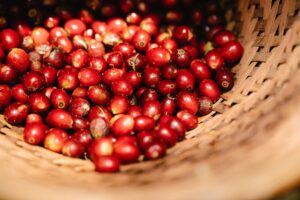Coffee Producing Countries 2022
Gangga Roastery – Did you know that coffee begins as a cherry tree’s fruit? That’s correct! Cherries are used to make coffee beans. Coffee, like any other product that begins as a seed and grows into a plant before becoming a finished product, does not grow well or sustainably in all places of the world. When looking at coffee-producing countries, you’ll see that the majority of them have similar geographic qualities.

It’s known as the Bean Belt, and it’s a great place to grow coffee. The area between 25° N and 30° S is referred to in this term. Coffee thrives in warmer climates, thus locations that are too far north or south of the equator will not be viable for growing coffee. Africa, Asia, South America, and North America, with the exception of Canada, are the most prevalent destinations for coffee exports and imports.
Coffee is produced in almost seventy nations, however not every country that grows cherry trees and roasts coffee beans also exports its product. There are fifty coffee-producing countries that export their product to buyers all over the world, focusing on the countries that both produce and distribute coffee. Among the fifty countries that grow coffee on their own land are.
- Brazil
- Vietnam
- Colombia
- Indonesia
- Ethiopia
- Burundi
- The Philippines
- Togo
- Guinea
- Yemen
- Cuba
- Panama
- Bolivia
- Timor Leste
- The Central African Republic
- Nigeria
- Ghana
- Sierra Leone
- Angola
- Jamaica
- Paraguay
- Malawi
- Trinidad and Tobago
- Zimbabwe
- Liberia
- Honduras
- India
- Uganda
- Mexico
- Guatemala
- Peru
- Nicaragua
- China
- Côte d’Ivoire
- Costa Rica
- Kenya
- Papua New Guinea
- Tanzania
- El Salvador
- Ecuador
- Cameroon
- Laos
- Madagascar
- Gabon
- Thailand
- Venezuela
- The Dominican Republic
- Haiti
- The Democratic Republic of the Congo
- Rwanda
The following are the top ten countries with the highest rates of coffee production, in order of most coffee produced.
- Indonesia
- Brazil
- Vietnam
- Colombia
- Uganda
- Mexico
- Guatemala
- Ethiopia
- Honduras
- India
Now, here’s a quick rundown of the top five coffee-producing countries, so you can learn a bit more about three of the world’s most famous coffee destinations!

Indonesia
Indonesia is one of many Asian countries that produces a staggering amount of coffee every year. In fact, the country is home to around 1.5 million different farmers who own and operate their own coffee farms and production enterprises. Indonesia is home to some of the world’s rarest coffees, including, but not limited to, a bean known as Kopi Luwak. Indonesian coffee growers do not take planting, roasting, or producing coffee lightly, and it shows in the final product. For example, the Indonesian Kopi Luwak coffee bean is one of the most expensive in the world.
Brazil
Brazil is without a doubt the country that produces the most coffee per year, both in terms of pounds and volume. So Paulo, Parana, and Minas Gerais are the top three coffee-growing cities in Brazil, all of which are located in the country’s southeastern area. The dry process, in which the coffee is not washed with water as in the wet process, is the most often used method of coffee production. Rather, in a dry process, the coffee cherries are left out to air dry and are dried using the sun’s natural heat, making this the most natural method of coffee production.
Honduras
Make sure to double-check the date of the item you’re citing if you come across sources that don’t identify Honduras as the fifth-highest coffee-producing country. The basis for this claim is that Honduras was just ranked as the world’s fifth-largest coffee producer. Ethiopia was ranked fifth on the list of countries by yearly coffee production rates and values prior to the harvest year between 2016 and 2017. Honduras remained the fifth-largest coffee producer in the crop year that ran from 2017 to 2018, putting the country at number five on the list.
The environment must meet specific requirements in order for coffee to grow, one of which is a certain altitude level. There are geographical sites in Honduras that are almost three thousand feet higher than the required altitude. This provides Honduras an advantage over other coffee-producing countries, and it has undoubtedly aided the country’s coffee-growing success.


I am from Indonesia. I Love my Country